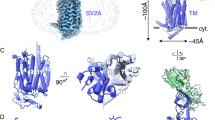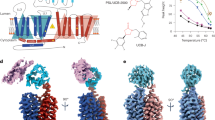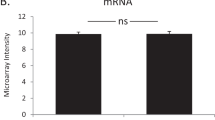Abstract
Synaptic Vesicle Glycoprotein 2 A (SV2A) is a membrane protein of synaptic vesicles and the binding site of antiepileptic drug levetiracetam. Biallelic Arg383Gln is reported in a family with intractable epilepsy earlier. Here, we report on the second family with early onset drug resistant epilepsy. We identified homozygous Arg289Ter variant by exome sequencing that segregated with the phenotype in the family. The affected children in these two families are normal at birth and developed recurrent seizures beginning in the second month of life and developed secondary failure of growth and development. Knock out mice models earlier had replicated the human phenotype observed in these two families. These findings support that biallelic loss of function variants in SV2A result in early onset intractable epilepsy in humans.
Similar content being viewed by others

Introduction
The synaptic vesicle glycoprotein family has three members, SV2A, SV2B, and SV2C, that are similar in structure but differ in expression pattern. The synaptic vesicle glycoprotein 2 A (SV2A, MIM#185860) is ubiquitously present in all brain regions, with peaks in the subcortical areas such as basal ganglia and thalamus [1]. The calcium-dependent synaptic vesicle release is regulated by SV2A, which is required for controlling neurotransmission [2]. SV2A is also the target for the antiepileptic drug levetiracetam. Animal models of mice and chicken showed that Sv2a loss-of-function (LOF) results in severe epilepsy and decreased lifespan, and heterozygous Sv2a LOF mice are ten times more prone to develop epilepsy than wildtype littermates [3].
To date, only a single report suggested that biallelic loss-of-function SV2A variants cause a severe phenotype of drug-resistant epileptic encephalopathy with microcephaly, developmental delay, movement disorder, and growth retardation [4]. The 5-year-old girl was normal at birth and had seizures beginning at 2 months of life. At six months of age, she had microcephaly, growth retardation, optic atrophy, and severe hypotonia. Brain imaging revealed diffuse increased T2 signal, thin corpus callosum, and mild ventriculomegaly at age 11 months. Exome sequencing identified a homozygous SV2A variant NM_014849.5:c.1148 G > A [p.(Arg383Gln)].
Three instances of heterozygous variants in SV2A possibly resulting in epilepsy have been documented. Wang and colleagues reported a young girl and her mother with a heterozygous variant (NM_014849.5:c.1708C > T, p.Arg570Cys) [5]. Calame and colleagues reported on a two-year-old child with new-onset epilepsy and a de novo rare heterozygous variant in SV2A (NM_014849.5:c.1978G > A, p.Gly660Arg) [6]. The same variant was observed in another family [7]. A summary of all variants associated with epilepsy in SV2A are provided in Table 1.
Clinical report
The proband is a five-years-old male child who was born to a second gravida. Fetal intrauterine growth restriction was noted and delivery was induced at 37 weeks of gestation in view of severe oligohydramnios. The delivery and neonatal period were unremarkable. Birth weight (2.24 kg) and head circumference (31.5 cm) were both at the 5th percentile. At the age of 40 days, he started to have generalized tonic clonic seizures during an episode of upper respiratory tract infection. He continued to have frequent treatment refractory seizures thereafter. He required four anticonvulsants that achieved only a partial control of his seizures. At the age of 11 weeks, he had partial head control, social smile, cooing, response to sounds, and he was able to fix and follow on objects. At the age of seven months, his seizures were 3–6 clusters of very brief clonic jerks occurring about twice daily and tended to increase with irritability. He had complete head lag, generalized hypotonia, hyperreflexia with bilateral ankle clonus. He lost his social smile and response to sounds and was unable to focus on objects. He lost his ability to lift his limbs against gravity by the end of first year. At the age of 4 years, his oral intake was negligible and he developed severe malnutrition and was admitted with bradycardia, hypotension and hypothermia that was associated with hypothyroidism and secondary malnutrition. The nutritional status improved by placing him on continuous nasogastric tube feeding but he continued to be failing to thrive. When assessed last at the age of five years, he was on phenobarbitone, clonazepam and topiramate but continued to have two to three episodes of brief self-limiting, generalized tonic clonic seizures daily. He showed failure to thrive and microcephaly. Weight was 10.9 kg (−5.7 SD), length 97 cm (−3.9 SD), and head circumference 47 cm (−3.8 SD). He had thick and arched eyebrows, long eyelashes, pectus carinatum and distal contractures. There was no organomegaly. He had generalized hypotonia with hyporeflexia and minimal spontaneous movements by then. His parents are healthy and are first cousins. His mother had an intrauterine fetal death at 23 weeks gestation earlier. He has two younger siblings, a four-year-old sister, and a two-year-old brother who are healthy.
Multiple electroencephalograms (EEGs) were consistent with an epileptic encephalopathy syndrome. An EEG done at the age of 21 months showed burst-suppression pattern of varying interval which was attenuated during arousal and replaced by continuous, multifocal spike wave discharges. Brain magnetic resonance imaging the age of 12 weeks was unremarkable. Eye examination at the age of two years showed bilateral severe cortical visual impairment with no structural ocular abnormalities. He had ammonia, transaminases, creatine kinase, acylcarnitine and amino acid profile in the normal range. Plasma lactate was always normal except for one episode of elevated lactate during seizures (up to 6.5 mmol/L). Cerebrospinal fluid glucose, and lactate were within normal limits and protein was slightly elevated (0.56 g/L, normal: 0.15–0.45 g/L) and amino acids showed elevated taurine and glycine that was explained by blood contamination. Neurotransmitter levels in cerebrospinal fluid was unremarkable.
Diagnostic clinical exome sequencing was conducted using Twist Human Core Exome Kit (TWIST Bioscience, San Francisco, USA) and sequencing using an Illumina platform (Illumina Inc., San Diego, USA). Variant filtration and prioritization as per standard in house protocol did not reveal any clinically significant variants that could explain his phenotype. We noted homozygosity for SV2A [NM_014849.5:c.865 C > T; NP_055664.3:p.(Arg289Ter) in exon 4] as a possible candidate. This variant is located at a highly conserved region of SV2A between the code for transmembrane domains 4 and 5 of SV2A (that has 12 transmembrane domains) and is predicted to result in a premature stop codon and cause loss-of-function through nonsense mediated decay. The variant is absent for public databases and our in-house exome data of 2000 individuals. Sanger sequencing using the primers SV2A_F-GGCTTTATGTGTGAGATGGAGT and SV2A_R-AGGGAGAAAGTGACAGCATC confirmed segregation of the variant in the family (Fig. 1) (variant is submitted to ClinVar: SUB13481551).
As he also harbored a synonymous variant NDUFS2: c.1212 G > A, p.(Lys404Lys). NDUFS2 is a subunit of complex 1 and this variant was confirmed to be benign through a normal complex one activity (and other respiratory chain enzymes) in skin fibroblasts. The parents provided consent for the publication of photographs. Exome sequencing was done as a clinical test. The study conforms the locally prevalent guidelines on ethical research.
Discussion
Multiple lines of investigations suggest variants in SV2A might be associated with brain disorders. Synaptic vesicle protein 2 (SV2) is a membrane glycoprotein typical to all synaptic and endocrine vesicles. Crowder and colleagues generated mice that do not express the primary Sv2 isoform, Sv2a, to explore its role in synaptic events using targeted gene disruption. Electrophysiological studies revealed that loss of Sv2a leads to a reduction in action potential-dependent GABAergic neurotransmission in the CA3 region of the hippocampus, while action potential-independent neurotransmission was normal. These findings demonstrate that Sv2a is an essential protein and implicates it in the control of exocytosis [3]. The synaptic vesicle protein Sv2a is the brain binding site of levetiracetam (LEV), an antiepileptic drug with a unique activity profile in animal models of seizure and epilepsy. Brain membranes and purified synaptic vesicles from mice lacking Sv2a do not bind a tritiated LEV derivative, indicating that Sv2a is necessary for LEV binding. Furthermore, a high correlation exists between binding affinities of a series of LEV derivatives to Sv2a in fibroblasts and to the LEV-binding site in the brain. These results suggest that Sv2a is the binding site of LEV in the brain and that LEV acts by modulating [8].
To date, only one report on one patient implicated biallelic pathogenic mutation in SV2A, with intractable epilepsy, developmental delay and microcephaly. Both asymptomatic parents were carriers for the Arg383Gln variant, suggesting a recessive inheritance. The mutation is located in the second adenine binding ___domain in SV2A protein and may alter adenine nucleotides binding to SV2A [4]. However, recently a study investigated whether this SV2A mutation (Arg383Gln) found in a human disease could shed light on which SV2A-dependent events are essential for the development of epilepsy. In order to imitate the homozygous state in humans, Harper and colleagues used a molecular replacement technique in which exogenous SV2A was expressed in mouse neuronal cells of either sex that had been depleted of endogenous SV2A. The Arg383Gln mutation caused SV2A to be mislocalized from SVs to the plasma membrane but had no impact on its activity-dependent trafficking. When stranded on the plasma membrane, this SV2A mutant showed decreased mobility and decreased binding to its interaction partner synaptotagmin-1 (Syt1). Additionally, in the absence of endogenous SV2A, the Arg383Gln mutant was unable to restore Syt1’s decreased expression and defective activity-dependent trafficking. This shows that a critical factor caused by loss of SV2A function may be the inability to control Syt1 expression and trafficking at the presynapse leading to seizure phenotype [9]. We could not estimate the SV2A levels in patient cells here.
Our patient presented with a phenotype similar to the reported individual with a biallelic SV2A variant. The phenotype includes asymptomatic neonatal period, an early onset with secondary microcephaly, growth retardation, optic atrophy, and severe hypotonia. Seizures start during the first two months of age, of generalized nature, and poorly controlled on multiple medications. The electroencephalographs were abnormal. Early death is reported in the affected sib of the first reported proband [4]. Our patient had a neuroimaging at 12 weeks that was unremarkable where as the abnormalities seen in the patient described by Serajee and Huq (2015) could be secondary to intractable epilepsy.
It is interesting to note that two heterozygous variants were reported in three families with possible association with epilepsy, however with normal head circumference and cognitive abilities and with no other syndromic features [5,6,7]. Both the variants are missense and are seen in gnomAD. Presence of several individuals carrying missense and predicted loss of function variants in gnomAD and healthy parents in this study as well as the previous study do not support dominant inheritance of epilepsy for SV2A variants [4]. Though these observations might suggest monoallelic hypomorphic variants underlie an increased susceptibility to seizures, further studies are required to study the association of heterozygous variants of SV2A and epilepsy.
Data availability
Data available on request from the authors
References
Rossi R, Arjmand S, Bærentzen SL, Gjedde A, Landau AM. Synaptic vesicle glycoprotein 2A: features and functions. Front Neurosci. 2022;16:864514.
Nowack A, Yao J, Custer KL, Bajjalieh SM. SV2 regulates neurotransmitter release via multiple mechanisms. Am J Physiol Cell Physiol. 2010;299:C960–7.
Crowder KM, Gunther JM, Jones TA, Hale BD, Zhang HZ, Peterson MR, et al. Abnormal neurotransmission in mice lacking synaptic vesicle protein 2A (SV2A). Proc Natl Acad Sci USA. 1999;96:15268–73.
Serajee FJ, Huq AM. Homozygous mutation in synaptic vesicle glycoprotein 2A gene results in intractable epilepsy, involuntary movements, microcephaly, and developmental and growth retardation. Pediatr Neurol. 2015;52:642–6.e1.
Wang D, Zhou Q, Ren L, Lin Y, Gao L, Du J, et al. Levetiracetam-induced a new seizure type in a girl with a novel SV2A gene mutation. Clin Neurol Neurosurg. 2019;181:64–6.
Calame DG, Herman I, Riviello JJ. A de novo heterozygous rare variant in SV2A causes epilepsy and levetiracetam-induced drug-resistant status epilepticus. Epilepsy Behav Rep. 2021;15:100425.
Badura-Stronka M, Kuszel Ł, Wencel-Warot A, Cudnoch K, Wołyńska K, Rutkowska K, et al. Broadening the phenotypic spectrum of the presumably epilepsy-related SV2A gene variants. Epilepsy Res. 2023;190:107101.
Lynch BA, Lambeng N, Nocka K, Kensel-Hammes P, Bajjalieh SM, Matagne A, et al. The synaptic vesicle protein SV2A is the binding site for the antiepileptic drug levetiracetam. Proc Natl Acad Sci USA. 2004;101:9861–6.
Harper CB, Small C, Davenport EC, Low DW, Smillie KJ, Martínez-Mármol R, et al. An epilepsy-associated SV2A mutation disrupts synaptotagmin-1 expression and activity-dependent trafficking. J Neurosci. 2020;40:4586–95.
Author information
Authors and Affiliations
Contributions
AAM: concept and identification of the variant by exome analysis and drafting the first version of the manuscript. FAM: concept and clinical evaluation of the patient and data analysis. AAF, AM, AAH: clinical data collection and concept. KMG: concept, and critical revision of the first version. All authors have edited the manuscript drafts and revisions and approved the final version of the manuscript.
Corresponding author
Ethics declarations
Competing interests
The authors declare no competing interests.
Ethics approval
The tests were performed on a clinical basis and consent was obtained from parents for publication of photographs.
Additional information
Publisher’s note Springer Nature remains neutral with regard to jurisdictional claims in published maps and institutional affiliations.
Rights and permissions
Springer Nature or its licensor (e.g. a society or other partner) holds exclusive rights to this article under a publishing agreement with the author(s) or other rightsholder(s); author self-archiving of the accepted manuscript version of this article is solely governed by the terms of such publishing agreement and applicable law.
About this article
Cite this article
Al-Maawali, A., Al-Murshedi, F., Al-Futaisi, A. et al. Biallelic variants in the synaptic vesicle glycoprotein 2 A are associated with epileptic encephalopathy. Eur J Hum Genet 32, 243–246 (2024). https://doi.org/10.1038/s41431-023-01493-8
Received:
Revised:
Accepted:
Published:
Issue Date:
DOI: https://doi.org/10.1038/s41431-023-01493-8
This article is cited by
-
Using exomes better
European Journal of Human Genetics (2024)



